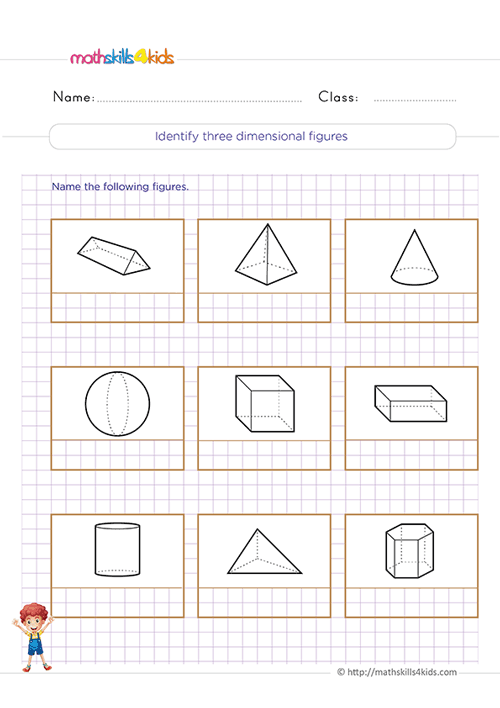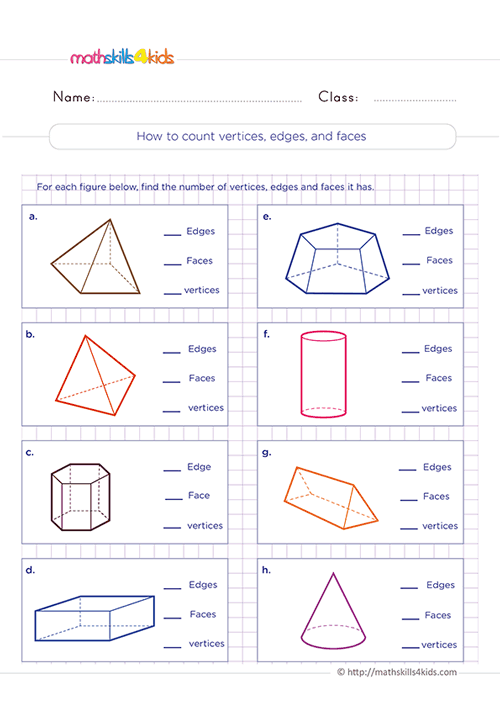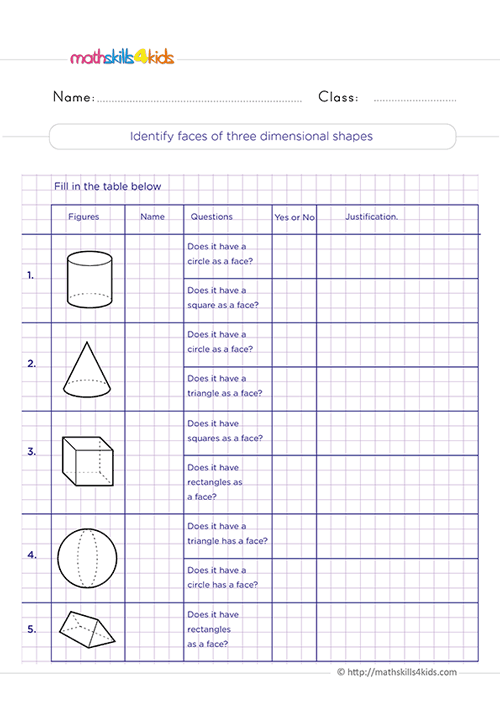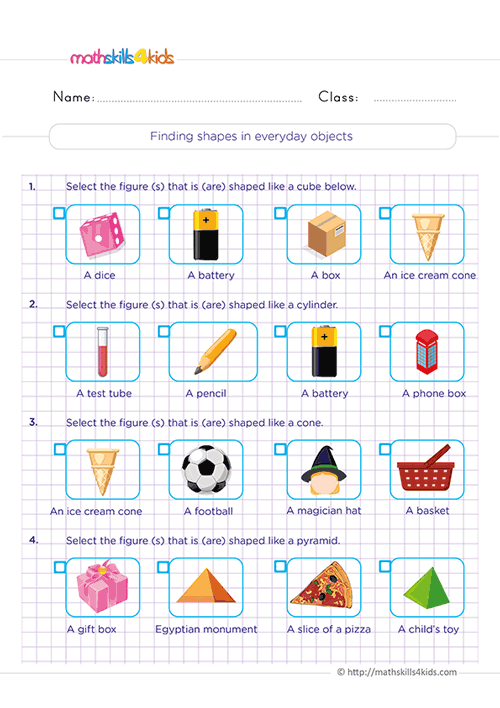Free printable 3rd Grade worksheets for practicing 3D shapes
Spark your 3Grader’s interest in learning about 3D shapes with engaging worksheets and activities from Mathskills4kids. In this article, we will help your 3rd graders familiarize themselves with common three-dimensional forms and what they look like in the real world, plus free printable 3rd Grade worksheets for practicing 3D shapes.
-
Also, your 3rd graders will explore the amazing, what they are and how to identify them, how to draw them, and why they matter.
Teaching and learning about 3D shapes is fun and very important for your math and science skills. So let's get started!
Introduction to 3D shapes
Learning about shapes can be very intimidating to some kids. However, a short and fun introduction to 3D shapes will help kids to develop a positive attitude and love for learning.
3D shapes have three dimensions: length, width, and height. They are different from 2D shapes, which only have two dimensions: length and width. Some examples of 3D shapes are cubes, spheres, cones, cylinders, pyramids, and prisms. You can see 3D shapes around you in the real world, such as buildings, balls, cans, hats, boxes, and more.
Learning about 3D shapes is important for 3rd graders because it helps them develop spatial reasoning skills. Spatial reasoning is the ability to imagine and manipulate objects in space. It is essential for many activities, such as solving puzzles, playing games, reading maps, designing buildings, etc. By learning about 3D shapes, you will be able to recognize them, describe them, compare them, and create them.
-
BROWSE THE WEBSITE
-
DOWNLOAD FREE WORKSHEETS
-
-
3rd GRADE MATH TOPICS
- Number and compapring
- Place value
- Addition
- Subtraction
- Understand multiplication
- Multiplication skill builders
- Multiplication fluency
- Multiplication
- Understand division
- Division skill builders
- Division fluency
- Division practice
- Mixed operation
- Properties
- Equations & variations
- Estimate & rounding
- Logical reasoning
- Patterns
- Money
- Telling time
- Data graph & probability
- Understanding fractions
- Equivalent fractions
- Comparing and ordering fractions
- Operations with fractions
- Unit of measurement
- Two-dimensional shapes
- Triangles and quadrilaterals
- 3D shapes
- Geometric measurement
-
Buying is supporting us!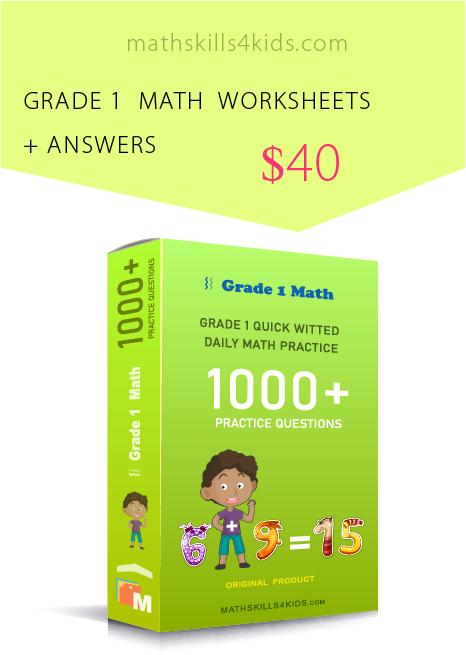
Buy Now...
-
-
Why 3D shapes matter for 3rd Graders
As mentioned before, 3D shapes matter for 3rd graders for many reasons. First, 3D shapes are everywhere in the real world. They are part of our everyday life and environment.
So, by learning about 3D shapes, your young math learners will be able to understand how things are made and how they work. For example, they will be able to see how a cube can be used to make a dice or a Rubik's cube, how a cone can be used to make an ice cream cone or a traffic cone, how a cylinder can be used to make a soda can or a pipe, and so on.
Secondly, learning about 3D shapes helps 3rd graders develop spatial reasoning skills. Spatial reasoning is important for many subjects in school, such as math, science, art, and engineering.
By learning about 3D shapes, 3rd Grade students can solve problems involving geometry, measurement, symmetry, patterns, transformations, and more. They can also express their creativity and imagination by drawing and making 3D shapes.
-
What are 3d shapes, and how to identify them
As we said before, 3D shapes have three dimensions: length, width, and height. They are also called solid shapes because they have volume or space inside them. You can touch them and feel their surfaces.
To identify 3D shapes, look at their properties or characteristics. Some of the properties of 3D shapes are:
- The number of faces they have. A face is a flat surface of a 3D shape.
- The number of edges they have. An edge is where two faces meet.
- The number of vertices they have. A vertex is where three or more edges meet.
- The shape of their faces. Some faces can be squares, rectangles, triangles, circles, or other polygons.
- The type of their edges. Some edges can be straight or curved.
- The type of their vertices. Some vertices can be pointed or rounded.
For example, a cube has six faces that are all squares. It has twelve edges that are all straight. It has eight vertices that are all pointed. A sphere has one face that is curved all around. It has no edges or vertices.
Here are some examples of common 3D shapes and their properties:
Shape
Faces
Edges
Vertices
Face Shape
Edge Type
Vertex Type
Cube
6
12
8
Square
Straight
Pointed
Sphere
1
0
0
Curved
None
None
Cone
2
1
1
Circle and Triangle
Curved and Straight
Pointed and Rounded
Cylinder
3
2
0
Circle and Rectangle
Curved and Straight
None
Pyramid
5 or more
Twice the number of faces minus two
One less than the number of faces
Triangle and Polygon, usually (Square)
Straight
Pointed
Prism
As many as the number of sides of the base polygon plus two (usually six)
Three times the number of sides of the base polygon (usually nine)
Twice the number of sides of the base polygon (usually six)
Polygon (usually Rectangle) and Polygon (usually Triangle)
Straight
Pointed
-
How to count 3d shapes’ faces, edges, and vertices: Best strategy from Mathskills4kids.com
One way to help 3rd graders practice their 3D shapes skills is to count the number of faces, edges, and vertices of different 3D shapes. Visit Mathskills4kids.com and grasp the best strategies and tips for counting, identifying, and comparing 3D shapes:
To count the faces, edges, and vertices of a 3D shape, you can use these tips to teach kids:
- Ask them to look at the shape from different angles and perspectives. This can help them to see all the faces, edges, and vertices clearly.
- Ask them to use their fingers or a pencil to trace the faces, edges, and vertices. This can help them track what you have counted and avoid repeating or missing any.
- Encourage them to use a formula or a pattern to find the number of faces, edges, and vertices. For some 3D shapes, some formulas or patterns can help your students quickly find the number of faces, edges, and vertices.
For example, for a cube, they can use the formula F = 6, E = 12, V = 8.
For a prism, they can use the pattern F = B + 2, E = 3B, V = 2B, where B is the number of sides of the base polygon.
Here are some examples of how to count the faces, edges, and vertices of some 3D shapes:
- A cube has six faces that are all squares. To count them, your students can look at each side of the cube and count one face for each side. They can also use the formula F = 6.
A cube has twelve edges that are all straight. To count them, look at each corner of the cube and count two edges for each corner. They can also use the formula E = 12.
A cube has eight vertices that are all pointed. To count them, they can look at each corner of the cube and count one vertex for each corner. You can also use the formula V = 8.
- A sphere has one face that is curved all around. To count it, tell your kids to look at the whole surface of the sphere and count one face for it. They can also use the formula F = 1.
A sphere has no edges or vertices. To count them, kids can look at the sphere’s surface and see no lines or points. They can also use the formulas E = 0 and V = 0.
- A cone has two faces: one that is a circle and one that is a triangle. To count them, your Grade 3 students can look at the cone’s base and side and count one face for each. They can also use the formula F = 2.
A cone has one curved edge. To count it, kids can look at the rim of the base of the cone and count one edge for it. They can also use the formula E = 1.
A cone has one vertex that is pointed. To count it, they can look at the tip of the cone and count one vertex for it. They can also use the formula V = 1.
-
How to draw 3D shapes
Another way to help 3d graders practice their 3D shapes skills is to draw them on paper or a computer. Drawing 3D shapes can help children visualize them better and express their creativity.
To draw 3D shapes, your 3rd graders can use these tips:
- Use basic shapes as building blocks. They can start by drawing simple shapes like squares, circles, triangles, or polygons and then add details to make them look like 3D shapes.
- Use shading and shadows to create depth and perspective. 3rd graders can use different shades of color or strokes to make some parts of the shape look darker or lighter. This can help them to create an illusion of depth and perspective.
- Also, kids can use dotted or dashed lines to show hidden parts of the shape. They can use dotted or dashed lines to show parts of the shape that are behind other parts or not visible from your point of view.
- Use labels or symbols to indicate the properties of the shape. Kids can use labels or symbols to show the number of faces, edges, or vertices of the shape or to show the shape of their faces.
Here are some examples of how to draw some 3D shapes:
- To draw a cube, start by drawing two squares that are slightly offset from each other. Then connect their corresponding corners with straight lines to form a cube shape. You can shade some parts of the cube to make it look more realistic. You can also label their faces with numbers or letters to show their properties.
- To draw a sphere, start by drawing a circle on paper or a computer screen. Then shade it with different colors or strokes to make it look more spherical. You can also add a shadow below it to make it look more realistic.
- To draw a cone, draw a circle on paper or a computer screen. Then draw a triangle above it with its base touching the circle and its vertex pointing up. Then erase or hide part of the circle inside the triangle to form a cone shape. You can shade some parts of the cone to make it look more realistic.
-
Fun activities to practice 3D shapes skills
Apart from using free printable 3rd Grade worksheets for practicing 3D shapes, learning about 3D shapes can be fun and engaging with hands-on activities. Here are some ideas and fun activities that students can practice and reinforce their 3D shapes skills and have fun at the same time:
- Shape Hunt: Students can go on a scavenger hunt around the classroom or their home and look for objects that match different 3D shapes. They can use a checklist or a bingo card to keep track of the shapes they find and compare them with their classmates or family members.
- Shape Sort: Students can sort various objects into groups based on their 3D shapes. They can use containers, baskets, or boxes to separate the objects by shape and label them with the shape’s name. They can also sort the objects by other criteria, such as color, size, or function.
- Shape Model: Students can use clay, playdough, or other materials to create models of 3D shapes. They can use tools such as toothpicks, straws, or pipe cleaners to make the edges and vertices of the shapes. They can also decorate their models with stickers, beads, or other items to make them more colorful and creative.
- Shape Puzzle: Students can cut out pictures of 3D shapes from magazines, newspapers, or online sources and glue them onto cardboard or paper. They can then cut the shapes along the edges and mix them up. They can challenge themselves or their peers to assemble the puzzle pieces and name the shapes they see.
- Shape Game: Students can play games that involve 3D shapes, such as memory, matching, or bingo. They can use cards, dice, or spinners to generate random shapes and try to find their pairs, match them with their names or properties, or mark them on their bingo cards. They can also make up their rules and variations to make the games more fun and challenging.
These are just some activities students can do to practice their 3D shapes skills. There are many more possibilities that students can explore and invent on their own. The key is to make learning about 3D shapes enjoyable and meaningful for 3rd graders.
-
Some real-world examples of 3D shapes
One of the reasons why learning about 3D shapes is important for 3rd graders is because they are everywhere in the real world. Recognizing and understanding 3D shapes can help students appreciate the beauty and diversity of nature and human-made objects. It can also help them solve problems and make decisions in everyday life.
Here are some examples of 3D shapes students might see in the real world:
- Sphere: A sphere is round with no faces, edges, or vertices. It is the same shape as a ball, a globe, a bubble, or an orange.
- Cube: A cube is a shape that has six square faces, twelve edges, and eight vertices. It is the same shape as a dice, a Rubik's cube, a sugar cube, or an ice cube.
- Cylinder: A cylinder is a shape that has two circular faces and one curved face. It has no vertices and two edges. It is the same shape as a soda can, a toilet paper roll, a candle, or a drum.
- Cone: A cone is a shape that has one circular face and one curved face. It has one vertex and one edge. It is the same shape as an ice cream cone, a party hat, a traffic cone, or a megaphone.
- Pyramid: A pyramid is a shape that has one polygonal face (usually a square) and four triangular faces. It has five vertices and eight edges. It is the same shape as the Egyptian pyramids, a tent, a cheese wedge, or a roof.
- Prism: A prism is a shape that has two polygonal faces (usually rectangles) and several rectangular faces. It has as many vertices and edges as its base polygon has sides. It is the same shape as a box, a book, a brick, or a prism.
These are just some examples of 3D shapes students might encounter in the real world. There are many more examples that students can discover and explore by observing their surroundings and using their imagination.
Bonus: Find more resources and free printable 3rd Grade worksheets for practicing 3D shapes learning here!
If you want to find more resources, activities, and free printable 3rd Grade worksheets for practicing 3D shapes learning, you are in luck! Many online sources offer interactive games, videos, worksheets, quizzes, and more to help you master your 3D shapes skills.
Here are some of the resources you can check out:
- Math Playground: This website offers fun and engaging games that let you practice identifying, sorting, drawing, and building 3D shapes. You can also learn about the properties and formulas of 3D shapes and test your knowledge with quizzes and puzzles. https://www.mathplayground.com/3d_shapes.html
- Learning Time Fun: This website offers comprehensive and clear videos that explain the concepts and vocabulary of 3D shapes. You can also practice your skills with interactive exercises and quizzes that provide instant feedback and hints. https://www.youtube.com/watch?v=CkMcboPCg7A
- com: This website offers colorful and creative worksheets that let you practice your 3D shapes skills in various ways. You can also find fun activities and crafts that let you make your 3D shapes, models, and projects. https://www.education.com/worksheets/third-grade/geometry/
- IXL: This website offers an adaptive and personalized practice that lets you work on your 3D shapes skills at your own pace and level. You can also track your progress and achievements with awards and certificates. https://www.ixl.com/math/grade-3/identify-and-compare-three-dimensional-shapes
These are just some resources to reinforce your 3D shapes learning in 3rd Grade. There are many more resources that you can find online or offline that suit your kid’s needs and preferences.
-
Thank you for sharing the links of MathSkills4Kids.com with your loved ones. Your choice is greatly appreciated.
Conclusion: Keep Practicing and Have Fun
In this article, you have learned about 3D shapes for 3rd graders. You have learned why 3D shapes matter, what they are and how to identify them, how to count their faces, edges, and vertices, how to draw them, how to practice your skills with fun activities, and how to find real-world examples of them.
You have also learned about some additional resources that you can use to further your learning.
Learning about 3D shapes is important for 3rd graders because it helps them develop their spatial reasoning skills, which are essential for math, science, engineering, art, and more. It also helps them appreciate the beauty and diversity of the world.
We hope you have enjoyed this article and learned something new and useful. We encourage you to explore our Mathskills4kids’ free printable 3rd Grade worksheets for practicing 3D shapes plus other additional resources and encourage your 3rd graders to keep practicing their 3D shapes skills.
Remember, learning about 3D shapes can be fun and rewarding!
